Page 355 of 587
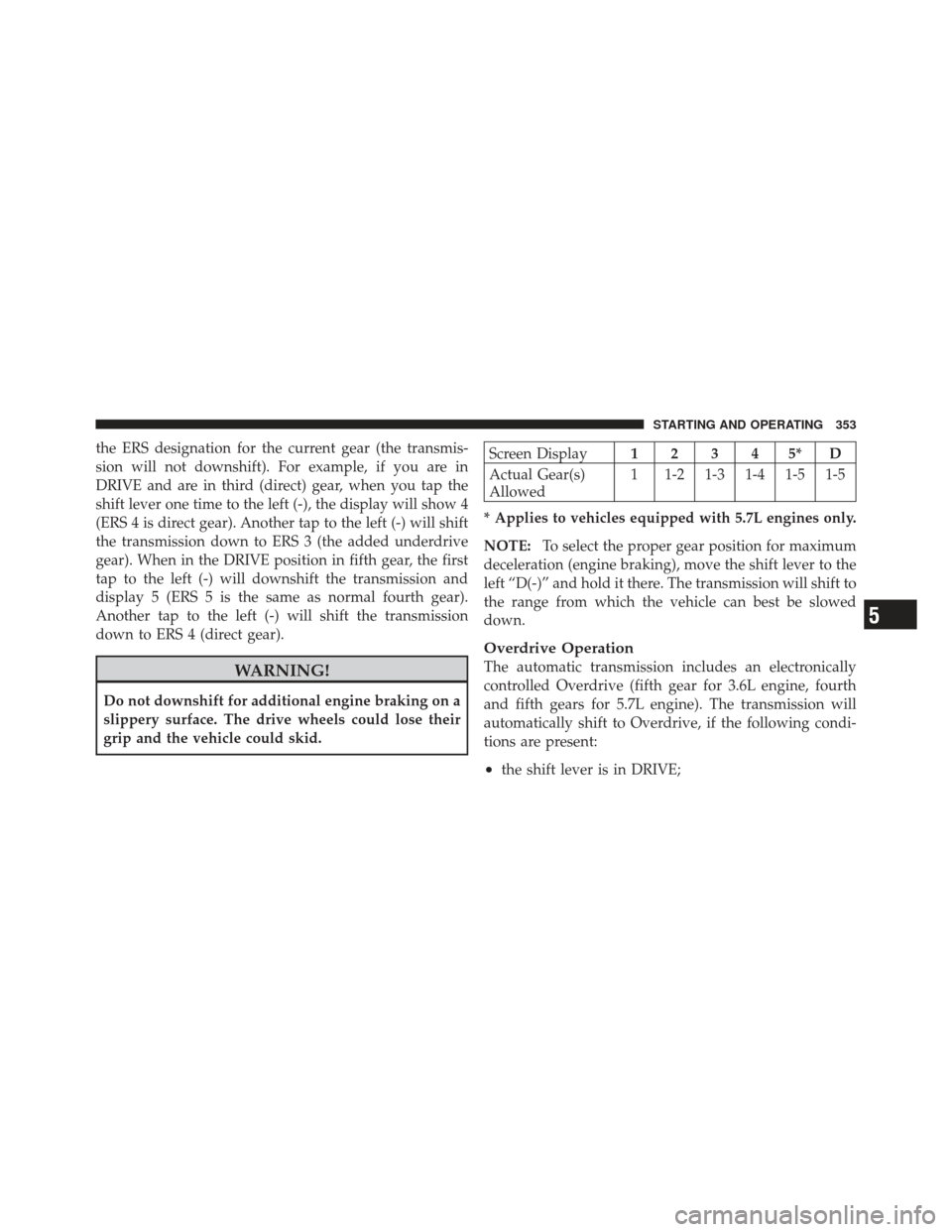
the ERS designation for the current gear (the transmis-
sion will not downshift). For example, if you are in
DRIVE and are in third (direct) gear, when you tap the
shift lever one time to the left (-), the display will show 4
(ERS 4 is direct gear). Another tap to the left (-) will shift
the transmission down to ERS 3 (the added underdrive
gear). When in the DRIVE position in fifth gear, the first
tap to the left (-) will downshift the transmission and
display 5 (ERS 5 is the same as normal fourth gear).
Another tap to the left (-) will shift the transmission
down to ERS 4 (direct gear).
WARNING!
Do not downshift for additional engine braking on a
slippery surface. The drive wheels could lose their
grip and the vehicle could skid.
Screen Display12345*D
Actual Gear(s)
Allowed 1 1-2 1-3 1-4 1-5 1-5
* Applies to vehicles equipped with 5.7L engines only.
NOTE: To select the proper gear position for maximum
deceleration (engine braking), move the shift lever to the
left “D(-)” and hold it there. The transmission will shift to
the range from which the vehicle can best be slowed
down.
Overdrive Operation
The automatic transmission includes an electronically
controlled Overdrive (fifth gear for 3.6L engine, fourth
and fifth gears for 5.7L engine). The transmission will
automatically shift to Overdrive, if the following condi-
tions are present:
•the shift lever is in DRIVE;
5
STARTING AND OPERATING 353
Page 359 of 587
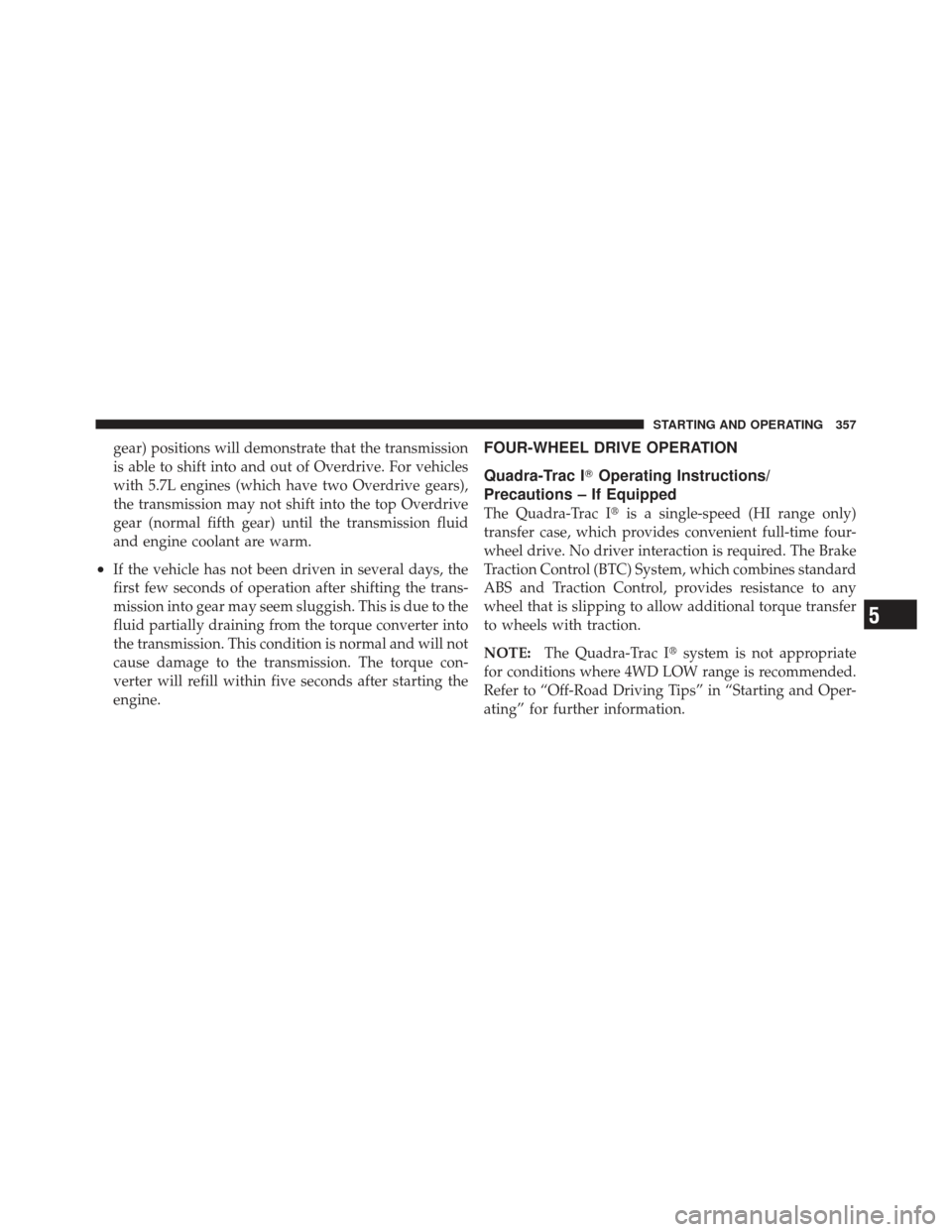
gear) positions will demonstrate that the transmission
is able to shift into and out of Overdrive. For vehicles
with 5.7L engines (which have two Overdrive gears),
the transmission may not shift into the top Overdrive
gear (normal fifth gear) until the transmission fluid
and engine coolant are warm.
•If the vehicle has not been driven in several days, the
first few seconds of operation after shifting the trans-
mission into gear may seem sluggish. This is due to the
fluid partially draining from the torque converter into
the transmission. This condition is normal and will not
cause damage to the transmission. The torque con-
verter will refill within five seconds after starting the
engine.
FOUR-WHEEL DRIVE OPERATION
Quadra-Trac I�Operating Instructions/
Precautions – If Equipped
The Quadra-Trac I� is a single-speed (HI range only)
transfer case, which provides convenient full-time four-
wheel drive. No driver interaction is required. The Brake
Traction Control (BTC) System, which combines standard
ABS and Traction Control, provides resistance to any
wheel that is slipping to allow additional torque transfer
to wheels with traction.
NOTE: The Quadra-Trac I� system is not appropriate
for conditions where 4WD LOW range is recommended.
Refer to “Off-Road Driving Tips” in “Starting and Oper-
ating” for further information.
5
STARTING AND OPERATING 357
Page 360 of 587
Quadra-Trac II�Operating Instructions/
Precautions – If Equipped
The Quadra-Trac II� transfer case is fully automatic in the
normal driving 4WD AUTO mode. The Quadra-Trac II �
transfer case provides three mode positions:
•4WD HI
•NEUTRAL
•4WD LOW
This transfer case is fully automatic in the 4WD HI mode.
When additional traction is required, the 4WD LOW
position can be used to lock the front and rear driveshafts
together and force the front and rear wheels to rotate at
the same speed. The 4WD LOW position is intended for
loose, slippery road surfaces only. Driving in the 4WD
LOW position on dry, hard-surfaced roads may cause
increased tire wear and damage to driveline components.
When operating your vehicle in 4WD LOW, the engine
speed is approximately three times that of the 4WD HI
position at a given road speed. Take care not to overspeed
the engine and do not exceed 25 mph (40 km/h).
Transfer Case Switch
358 STARTING AND OPERATING
Page 361 of 587
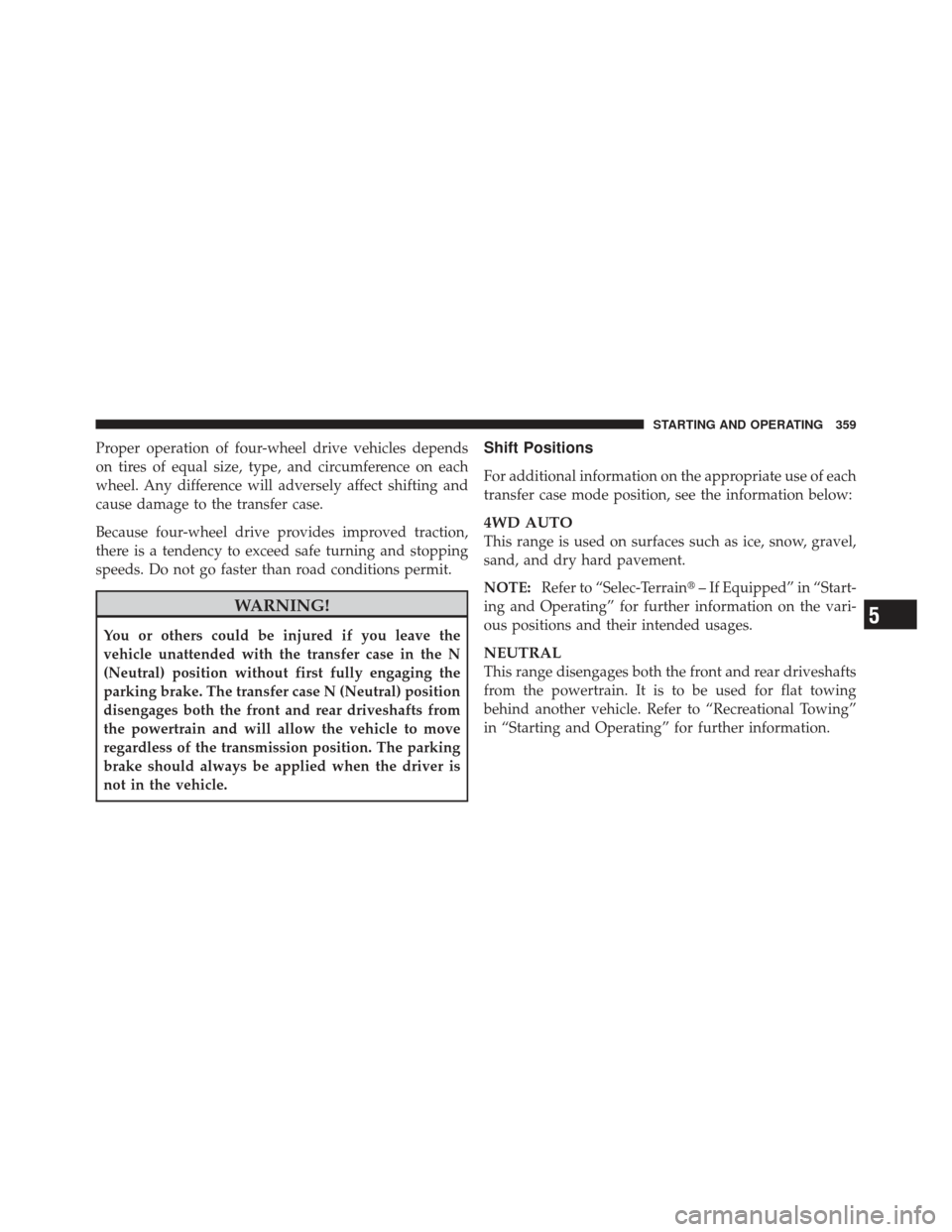
Proper operation of four-wheel drive vehicles depends
on tires of equal size, type, and circumference on each
wheel. Any difference will adversely affect shifting and
cause damage to the transfer case.
Because four-wheel drive provides improved traction,
there is a tendency to exceed safe turning and stopping
speeds. Do not go faster than road conditions permit.
WARNING!
You or others could be injured if you leave the
vehicle unattended with the transfer case in the N
(Neutral) position without first fully engaging the
parking brake. The transfer case N (Neutral) position
disengages both the front and rear driveshafts from
the powertrain and will allow the vehicle to move
regardless of the transmission position. The parking
brake should always be applied when the driver is
not in the vehicle.
Shift Positions
For additional information on the appropriate use of each
transfer case mode position, see the information below:
4WD AUTO
This range is used on surfaces such as ice, snow, gravel,
sand, and dry hard pavement.
NOTE:Refer to “Selec-Terrain� – If Equipped” in “Start-
ing and Operating” for further information on the vari-
ous positions and their intended usages.
NEUTRAL
This range disengages both the front and rear driveshafts
from the powertrain. It is to be used for flat towing
behind another vehicle. Refer to “Recreational Towing”
in “Starting and Operating” for further information.
5
STARTING AND OPERATING 359
Page 362 of 587
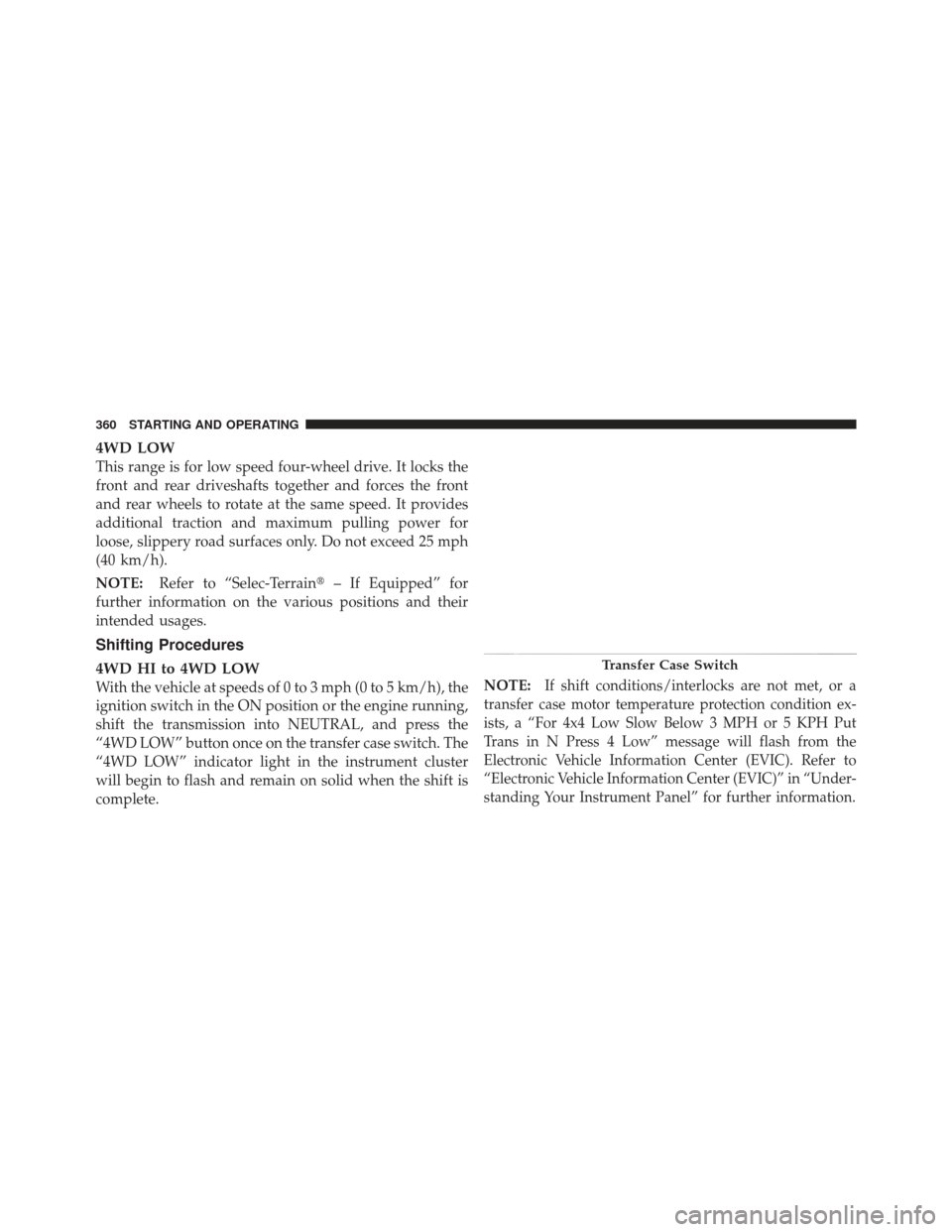
4WD LOW
This range is for low speed four-wheel drive. It locks the
front and rear driveshafts together and forces the front
and rear wheels to rotate at the same speed. It provides
additional traction and maximum pulling power for
loose, slippery road surfaces only. Do not exceed 25 mph
(40 km/h).
NOTE:Refer to “Selec-Terrain� – If Equipped” for
further information on the various positions and their
intended usages.
Shifting Procedures
4WDHIto4WDLOW
With the vehicle at speeds of 0 to 3 mph (0 to 5 km/h), the
ignition switch in the ON position or the engine running,
shift the transmission into NEUTRAL, and press the
“4WD LOW” button once on the transfer case switch. The
“4WD LOW” indicator light in the instrument cluster
will begin to flash and remain on solid when the shift is
complete. NOTE:If shift conditions/interlocks are not met, or a
transfer case motor temperature protection condition ex-
ists, a “For 4x4 Low Slow Below 3 MPH or 5 KPH Put
Trans in N Press 4 Low” message will flash from the
Electronic Vehicle Information Center (EVIC). Refer to
“Electronic Vehicle Information Center (EVIC)” in “Under-
standing Your Instrument Panel” for further information.
Transfer Case Switch
360 STARTING AND OPERATING
Page 364 of 587
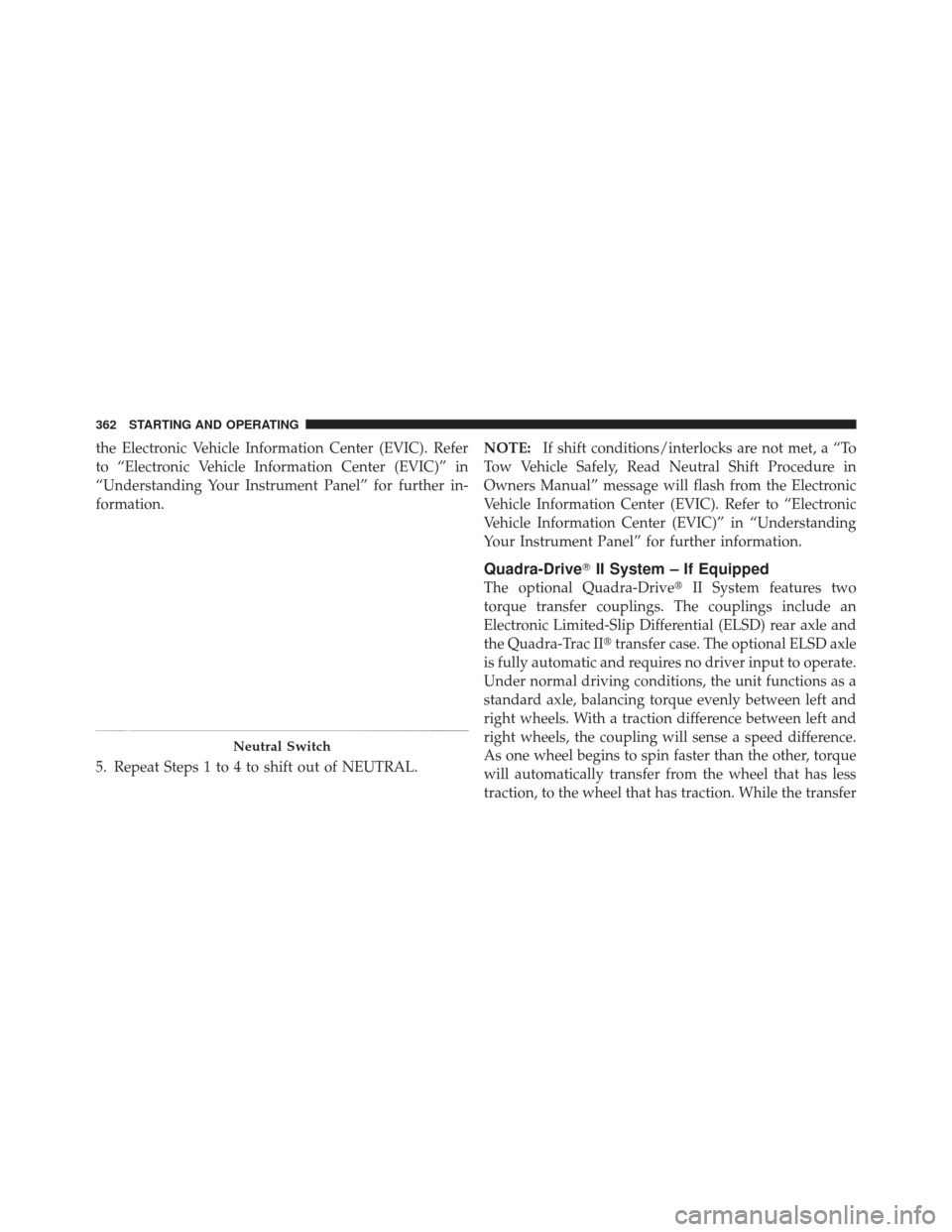
the Electronic Vehicle Information Center (EVIC). Refer
to “Electronic Vehicle Information Center (EVIC)” in
“Understanding Your Instrument Panel” for further in-
formation.
5. Repeat Steps 1 to 4 to shift out of NEUTRAL.NOTE:
If shift conditions/interlocks are not met, a “To
Tow Vehicle Safely, Read Neutral Shift Procedure in
Owners Manual” message will flash from the Electronic
Vehicle Information Center (EVIC). Refer to “Electronic
Vehicle Information Center (EVIC)” in “Understanding
Your Instrument Panel” for further information.
Quadra-Drive� II System – If Equipped
The optional Quadra-Drive� II System features two
torque transfer couplings. The couplings include an
Electronic Limited-Slip Differential (ELSD) rear axle and
the Quadra-Trac II� transfer case. The optional ELSD axle
is fully automatic and requires no driver input to operate.
Under normal driving conditions, the unit functions as a
standard axle, balancing torque evenly between left and
right wheels. With a traction difference between left and
right wheels, the coupling will sense a speed difference.
As one wheel begins to spin faster than the other, torque
will automatically transfer from the wheel that has less
traction, to the wheel that has traction. While the transfer
Neutral Switch
362 STARTING AND OPERATING
Page 365 of 587
case and axle coupling differ in design, their operation is
similar. Follow the Quadra-Trac II�transfer case shifting
information, preceding this section, for shifting this
system.
SELEC-TERRAIN™ — IF EQUIPPED
Description
Selec-Terrain™ combines the capabilities of the vehicle
control systems, along with driver input, to provide the
best performance for all terrains.
Selec-Terrain™ consists of the following positions:
•Sport– Dry weather, on-road calibration. Only avail-
able in 4WD High range. Performance based tuning
that provides a rear wheel drive feel but with im-
proved handling and acceleration over a two-wheel
drive vehicle. The Electronic Stability Control will set
Selec-Terrain™ Switch
5
STARTING AND OPERATING 363
Page 366 of 587

to allow more driver control of vehicle while maintain-
ing safe handling controls. The vehicle will lower (if
equipped with Air Suspension) to Aero Mode in High
Range. 4WD Low is not available in SPORT mode, if
4WD Low is selected the Selec-Terrain™ will auto-
matically switch back to AUTO.
•Snow– Tuning set for additional stability in inclement
weather. Use on and off road on loose traction surfaces
such as snow. When in Snow mode (depending on
certain operating conditions), the transmission may
use second gear (rather than first gear) during
launches, to minimize wheel slippage. If equipped
with air suspension, the level will change to Normal
Ride Height (NRH) if the transfer case is in high range.
The level will change to Off-Road 1 if the transfer case
is in Low range.
•Auto – Fully automatic full time four-wheel drive
operation can be used on and off road. Balances traction with seamless steering feel to provide im-
proved handling and acceleration over two-wheel
drive vehicles. If equipped with air suspension, the
level will change to NRH.
•Sand/Mud
– Off road calibration for use on low
traction surfaces such as mud, sand, or wet grass.
Driveline is maximized for traction. Some binding
may be felt on less forgiving surfaces. The electronic
brake controls are set to limit traction control manage-
ment of throttle and wheel spin. If equipped with air
suspension, the level will change to Off-Road 1.
•Rock – Off-road calibration only available in 4WD
Low range. The vehicle is raised (if equipped with Air
Suspension) for improved ground clearance. Traction
based tuning with improved steer-ability for use on
high traction off-road surfaces. Activates the Hill De-
scent Control for steep downhill control. Use for low
speed obstacles such as large rocks, deep ruts, etc. If
364 STARTING AND OPERATING